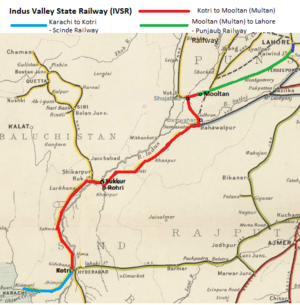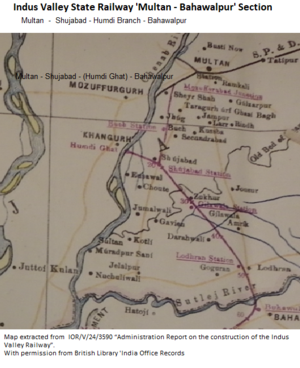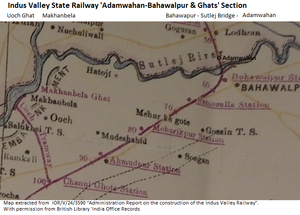Indus Valley State Railway - Survey and Construction
Indus Valley State Railway - Survey and Construction
- a sub-section of the Indus Valley State Railway(IVSR) page

The Indus Valley State Railway(IVSR) was to provide a rail link between Kotri and Mooltan((Multan). This was to complete a rail connection from the port of Karachi to Lahore by linking two lines:-
- The broad gauge(BG) line from the coast at Karachi to Kotri had been built by the ’ Scinde Railway Company’ and opened in 1861 [1].
- The broad gauge(BG) line from Lahore to Mooltan((Multan) built by the ’Punjaub Railway Company’, opened in 1865 [1].
Metre Gauge Survey and Construction
The connecting 500 miles(800km) was first surveyed in 1865 by John Brunton, the Chief Resident Engineer of Scinde Railway, assisted by his son William Arthur Brunton and this line was the eventual line that was built with the exception of the divergence to Shujabad. The route involved the crossing of two great Rivers
- The River Sutlej between Adamwahan and Bahawalpur - the Sutlej Bridge (which became the Empress Bridge when opened in 1878)
- The River Indus between Sukkur and Rohri – the Sukkur Bridge (which became the Lansdowne Bridge when opened in 1889)
He also surveyed a line for an alternative line below Sukkur on the left bank as far as Hyderabad.
Work started drawing up the route between Mooltan and Rohri in 1870-71. The initial gauge was to be metre gauge(MG) and in November 1871 sanction was given to start construction. In December 1871 the lower section between Sukkur to Kotri was surveyed about 230 miles(370km) and an estimate drawn up and this was agreed. The construction was to be worked on simultaneously and 3 divisions were set up:- ‘North Division’ Mooltan to mile 172; ‘Middle Division’ Upper Scinde to mile 338; and ‘South Division’ Lower Scinde to mile 500. The bridging of the two rivers with the Sutlej Bridge( linking Bahawalpur and Adamwahan ) and the Sukkur Bridge over the Indus River (to link Rohri to Sukkur) were kept separate and were Divisions in their own right. By 1873 the first 155 miles(250km) in the ‘North Division’ and 8 out of the 25 stations had been completed [2].
During 1873 the IVSR formed a ‘Sutlej River Conservancy Division’ - see separate page for the express purpose of controlling the River Sutlej and endeavouring to restrain its oscillations within fixed limits. A survey of the Sutlej River bed was made along with observations of flood levels. Trial wells for the footings were sunk to 100 feet. During the year the newly formed colony at Adamwahan (on the north bank of the River Sutlej) was flooded and the course of the river was altered eroding some 400 yards of bank. Little else was done along the length of the route [2]
After the initial survey the Government set up a committee to report on the Gauge of the network that would be preferred in the Indus Valley and else where in India. Having looked at various European systems there was a split in the decision. Mr Fowler published a minority report in 1870 recommending meter gauge(MG) whilst the majority had proposed the ‘Indian Standard’ broad 5ft 6 ins gauge(BG) [3].
Construction continued made using meter gauge (MG) until a final decision was made. By 1871 a total of 170 miles(270km) of embankments had been completed in the ‘North Division’ and, with the exception of the Sutlej Bridge, nearly all the bridges were complete with uncertainty of the gauge still to be resolved. All the stations were completed but the junction at Mooltan with the Scinde, Punjaub & Delhi Railway(SP&DR) was left in abeyance due to the uncertainty of the gauge. [4]. In the ‘Middle Division’ the embankments were completed a further 69 miles(111km). The establishment of a steam ferry between Sukkur and Rohri was started so as to join the sections together until the bridge was completed. In the ‘South Division’ section 150 miles(240km) of embankment were completed although the chief attention was at the bottom end at Kotri where the line joined the Scinde Railway line [2].
Arrangements were in place for the SP&DR to carrying materials landed at Karachi via the Indus Flotilla to the various IVSR Construction Depots. This involved the use of tramways from the Ghats on the River to the Depots (see below).
Trial wells were undertaken in 1872 for the 'Sutlej Bridge' (upon inaugeration in 1878 was named the ‘Empress Bridge’ - see separate page . Construction proper started in 1873.
Broad Gauge Conversion and Construction
In July 1874 the final decision on the gauge was made and it was decided that it should be 5-foot 6 inches broad gauge(BG).
As a consequence, the ‘Middle’ section works were closed, and work was concentrated at both the ‘North’ and ‘South’ Divisions to widen the embankments. The prospect of opening the ‘North’ section early was a possibility. The estimate for the BG line was submitted in November 1875 and there was uncertainty about the financing until the new estimate was agreed. After the floods of 1875 a distance of 55 miles(88km) of line had to be diverted eastward towards the high desert, this was not agreed until November 1876. Heavy Damage was also suffered at Adamwahan and in the aftermath of the floods a fever became prevalent (Malaria) causing great distress with sometimes no one fit for duty, most suffered multiple attacks.
In the ‘North’ section the line from Mooltan to Hamdi was converted to broad gauge(BG) and by April 1876 the line was open to Adamwahan connecting it directly to Calcutta and Bombay. In the ‘South Division’ by 1876 the’ Sann River Bridge’ (23 girder spans of 40 feet/12 mtr) was under construction; there were only two other large bridges in this section - the ‘Aral River Bridge’ ( spans of 40 feet/12 mtr) and the ‘Kara Fitta River Bridge’ (10 spans of 20 feet /6 mtr); some long culverts had also been constructed under the heavy embankment in the Laki pass, in which 170,000 cubic feet (4800 m3) of masonry, and 45,000 cubic feet (1300 m3) of concrete had been executed.
Unfortunately, the Scinde, Punjaub & Delhi Railway(SP&DR) and Indus Flotilla could not deal with the quantity of goods for the railway, so it became imperative to open the ‘North’ section railway to Rohri.
The 1877 inundation caused damage further down the line to the town and station of Ghotki below Sukkur and as far down as Sehwan were affected. At Kotri at the southern end of the line, the engine shed was completed, and engines acquired from the SP&DR and one hired from the Karachi Harbour works along with 75 ballast wagons. In 1878 a revised estimate of the cost less the cost of the Sutlej Bridge stood at Rs 60,133,417. The rail link with the Indus Flotilla ceased in 1877 due to lack of goods as most of the supplies by railway were in place.
The ‘Sutlej Bridge’ was completed in March 1878 and inaugurated on 7th June 1878 to be renamed the ’Empress Bridge’ - see separate page .
On the 1st July the line was officially opened for traffic from Mooltan down to Kotri but due to a lack of rolling stock the remaining 228 miles(367km) was not open to later. This was fortunate because a repeat of the earlier floods occurred and there was damage to the line near Sehwan .
Finally the IVSR line was in full operation on the 27th October 1878, except for the River Indus crossing linking Sukkur to Rohri where the a ferry was used whilst engineering challenge of the the ‘Sukkur Bridge’ was under construction.
A Conference was held at Lahore in November 1878 and a proposal was made by the Honourable Member of Council for Public Works to the Officers of the Scinde, Punjaub & Delhi Railway Company (SP&DR), that they should take over the working of the traffic of the Indus Valley State Railway to which the Directors of the Indus Valley State Railway agreed [5].
In 1886 the North Western Railway(NWR) was formed by the merger of the IVSR with the SP&DR and other railways. The ‘Sukkur Bridge’ was under construction and on inauguration in March 1889 was renamed the ‘Lansdown Bridge’ - see separate page thus providing an unbroken BG route from Lahore to the port of Karachi.
Extension Surveys
At the request of the Indian Government several surveys were made in 1877 to link the IVSR railway from Ruk northward towards Dadur via Shikarpur and Jacobabad to the frontier some 50 miles(80km) away. The other taking a more northerly direction from Shikarpur towards Ghurrie Hussan a distance of 41 miles(66km). The report was made. This preliminary survey and section of this route of 294¾ miles (475km) was made and an approximate estimate produced [6]. No action was taken until 1879 with the commencement of construction by the Sind-Pishin State Railway.
Further surveys were made from Hyderabad south-easterly to join the Bombay, Baroda and Central India Railway( BB&CIR) system at Deesa. The direct route via Omerkote and Deesa appearing impracticable, owing to its direction being crossed obliquely throughout the desert, which stretches between those two places by lofty ridges of sand hills, attention was devoted to the only promising route north of Rann of Kutch, that skirting its northern edge, and the crossing it via Nuggur Parker to Pahlanpur, and Kachh Booj route via Luckput and Bachow to Lilapur. This preliminary surveys and sections of this route of 351¼ miles(565km) in length was made and an approximate estimates produced. The line was not constructed [6].
IVSR Construction Tramways
Several tramways were laid to carry materials to the IVSR Construction Depots from quarries and from the rivers to carry goods delivered by the Indus Flotilla where the Depot was not near the River. The majority of these tramways were laid as metre gauge(MG). Some of these lines were later incorporated as branches of the IVSR system and converted into broad gauge(BG).

- Humdi Ghat Tramway (Branch Railway)
A MG line was laid from Humdi Ghat to Shujabad in the ‘North Division’, distance of 8 miles (13km) and the continued on another 5 miles(8km) towards Adamwahan in 1874. The intention was that this would eventually become part of the line and was converted to BG becoming part of the IVSR line. [7].

- Sutlej Bridge Construction Tramway
From 1874 materials for the construction of the Sutlej Bridge were carried by a MG Tramway using 3 MG tank locomotives and initially 10 wagons with 150 more wagons manufactured at Adamwahan. A large timber depot with steam swing machinery was also set up at Humdi. In 1875 this was extended to 63 miles(100km) of MG tramway to the Sutlej Bridge. The line was now being operated by 5 tank engines with 70 wagons and more added as the 150 became available. When in 1876 the tramline was finished it had carried 50,000 tons of stone for the bridge, 4,600 tons of iron permanent way material, 6,000 tons of sleepers, 15,000 tons of miscellaneous material, and 20,000 tons of ballast. The equipment was dismantled in 1875-76 and transferred to construct the Ghotki Tramway (see above) [8].
- Uoch Tramway (Branch Line)
The 14 mile(22km) Uoch Tramway, a MG line, was built in the ‘North Division’ from Channi Chota Station to the Chenab River at Uoch Ghat and on to Makbanbela. The tramway which was converted into a Branch line so that Goods and passengers could be transferred from the Indus Flotilla to the railway via a wooden pier at Makbanbela, this ceased in 1877 and the line was taken up [9].
- Sutlej Bridge South Bank Tramway
In 1878, to the south of the Suteji River, a broad-gauge tramway was connected to the main line at mile 55 by a branch tramway. No difficulties were encountered in the construction of the above to move earth for the beginning of the bridge works. On the north side a broad-gauge tramway was built reaching out on to the top of the protective bund [10].

- Ghotki-Rohri Stone Quarry Tramway
In 1872-73 near Ghotki (48 miles northeast of Rohri) a MG Tramway was laid from the quarries at Rohri for 24 miles(43km) through the Ghotki Sub-Division, to carry out the stone for the bridges. In 1876 about 5 miles(8km) more were Iaid in branches to the river at Sukkur and from several quarries to Rohri. In 1879 this was dismantled and the BG main line substituted [11].
- Ghokti Tramway (IVSR Mainline)
On conclusion of the major construction work on the ‘Sutlej Bridge’ in 1875-76, the Tramway and equipment was transferred to Ghotki. The tramway was laid along the bank and the materials for the embankment expansion and 36 Major bridges, many of which were viaducts, was transported. The Narra bridge with 8 spans of 20 feet arches, with two culverts near it was completed. 20 miles (32km) of main line had been laid on the bank, with deviations containing a trestle bridge at the bridge sites. The remainder of the main line was being rapidly urged forward, towards the northern end of the Division. Five MG tank locomotive engines and 100 ballast wagons were on the line, transferred from the Shujabad Division, and two more engines with about 60 more wagons were shortly to be brought down. The length of the tramway was extended to a length of 48 miles in 1877 and an extra tank engine and 58 low-sided wagons added [12]. Much of this section was then converted to BG becoming part of the ‘IVSR Mainline’
- Gobia Ghat Tramway
In 1876-77 a MG Tramway was established with Gobia, a Ghat on the River Indus about a day's steam above Sukkur, and but three or four miles distance from Sarhad station, at which the Indus Flotilla boats could conveniently discharge their cargoes [13].

- Futtahpur Ghat Tramway
In 1877 to transport the materials from the river at Fattehpur Bunder to the Phulji Road station a 3¾ mile(6km) Tramway was laid. [14].
Further Information
- See Indus Valley State Railway main page up to 1886
- and North Western Railway from 1886 onwards.
References
- ↑ 1.0 1.1 “Administration Report on Railways 1918” page 106 (pdf115) ; Retrieved 1 Jan 2018
- ↑ 2.0 2.1 2.2 British Library IOR/V/24/3590 “Administration Report on the construction of the Indus Valley Railway” pages 1-4
- ↑ Fowler British Library IOR/27/723/1 “Report on the best width for Narrow Gauge Railways for India and applicability in the Indus Valley” by J Fowler
- ↑ British Library IOR/V/24/3590 “Administration Report on the construction of the Indus Valley Railway” pages 4, 22-26
- ↑ British Library IOR/V/24/3590 “Administration Report on the construction of the Indus Valley Railway” pages 5-8,15,21 37
- ↑ 6.0 6.1 > British Library IOR/V/24/3590 “Administration Report on the construction of the Indus Valley Railway” pages 36-37
- ↑ ibid Page 9 para 50
- ↑ ibid Page 9 para 50
- ↑ ibid Page 5 para 25
- ↑ ibid Page 42 para 178
- ↑ British Library IOR/V/24/3590 “Administration Report on the construction of the Indus Valley Railway” Page 5 para 25
- ↑ ibid Page 14 para 75
- ↑ ibid Page 21 para 100
- ↑ ibid Page 30 para 135